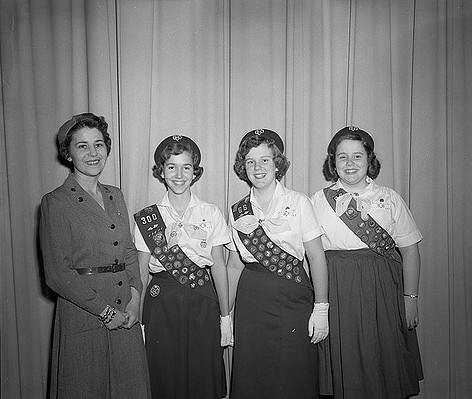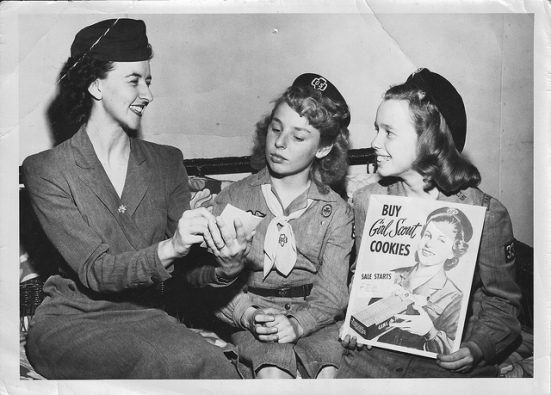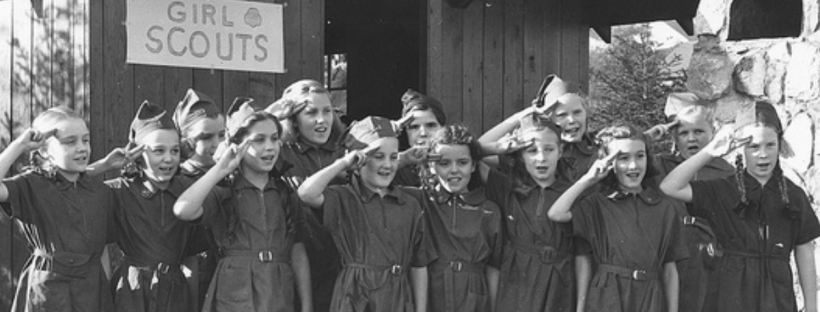Girl Scouts have been selling some of the nation’s most iconic cookies for over 100 years, all while helping girls learn five essential skills – goal setting, decision making, money management, people skills, and business ethics!
1910s
In 1917, five years after Juliette Gordon Low started Girl Scouts in the United States, the Mistletoe Troop in Muskogee, Oklahoma, baked cookies and sold them in its high school cafeteria as a service project. Troops began baking cookies in their own kitchens, along with their mothers volunteering as technical advisers, in order to finance troop activities.

Girl Scouts at Winston City High School (Winston, N.C.)
1920s
In 1922, director Florence E. Neil in Chicago, Illinois created a sugar cookie recipe that was then distributed to Girl Scouts of the USA’s 2,000 Girl Scouts. The recipe was published in Girl Scouts of the USA’s The American Girl magazine, and Girl Scouts continued to bake the cookies with their mothers throughout the decade. The girls packaged the cookies in wax paper bags and sold them door to door for 25 to 35 cents per dozen.
The Original Girl Scout Cookie Recipe from 1922:
- 1 cup of butter, or substitute
- 1 cup of sugar
- 2 tablespoons of milk
- 2 eggs
- 1 teaspoon of vanilla
- 2 cups of flour
- 2 teaspoons of baking powder
Cream butter and sugar; add well-beaten eggs, then milk, flavoring, flour, and baking powder. Roll thin and bake in quick oven. (Sprinkle sugar on top.)
This amount makes six to seven dozen.
Modern-day tips (not part of the original recipe): Refrigerate dough for at least one hour before rolling and cutting cookies. Bake in a quick oven (375°) for approximately 8 to 10 minutes or until the edges begin to brown.

Mrs. Coolidge eating cookies presented by a New York Girl Scout Troop, 1923
1930s
In 1933, Girl Scouts of Greater Philadelphia Council baked cookies and sold them in the city’s gas and electric company windows at just 23 cents per box of 44 cookies. Girls began raising funds for their local Girl Scout council, and in 1934, Greater Philadelphia became the first council to sell commercially baked cookies.
In 1935, the Girl Scout Federation of Greater New York bought its own die in the shape of a trefoil and used the words “Girl Scout Cookies” on the box. In 1936, the national Girl Scout organization began the process of licensing the first commercial bakers to produce cookies that would be sold nationwide. By 1937, more than 125 Girl Scout councils reported holding cookie sales.
1940s
Girl Scout Cookies were sold by local councils around the country until World War II. When sugar, flour, and butter were in a nation-wide shortage in 1944, Girl Scouts began selling calendars as an alternative to raise money for troop activities. After the war, cookie sales increased, and by 1948, a total of 29 bakers were licensed to bake Girl Scout Cookies.

Girl Scouts in the 1940s (Flickr: Seattle Municipal Archives)
1950s
In 1951, Girl Scout Cookies came in three varieties: Sandwich, Shortbread, and Chocolate Mints (now known as Thin Mints). With the development of suburban communities, girls began selling cookies at tables set up in shopping malls. Five years later, flavors expanded to four types of cookies: a vanilla-based filled cookie, a chocolate-based filled one, shortbread, and a chocolate mint.

Girl Scouts in 1958 (Flickr: The Library of Virginia)
1960s
During the 1960s, the Baby Boomers of the 50s significantly increased Girl Scout membership and cookie sales. Fourteen licensed bakers produced the cookies and wrapped them in printed aluminum foil or cellophane to preserve their freshness. By 1966, a number of varieties were available, including best-sellers Chocolate Mint, Shortbread, and Peanut Butter Sandwich cookies.
1970s
In 1978, the number of bakers was reduced to four to ensure lower prices and uniform quality, packaging, and distribution. For the first time, all cookie boxes (regardless of the baker) featured the same designs and scenes of Girl Scouts in action, including hiking and canoeing. The following year, the new Saul Bass–created Girl Scout logo appeared on cookie boxes along with the benefits of Girl Scouting. Girl Scout Cookies for sale during the 1970s included Thin Mints, Peanut Butter Sandwich/Do-si-dos®, and Shortbread/Trefoils® cookies, along with four additional choices.

Saul-Bass Logo
1980s
In 1982, four bakers still produced a maximum of seven varieties of cookies. While four varieties were optional, three were mandatory: Thin Mint®, Peanut Butter Sandwich/Do-si-dos®, and Shortbread/Trefoils®.
1990s
In the early 1990s, two licensed bakers baked Girl Scout cookies, which grew again to three bakers by 1998. Eight cookie varieties were available, including low-fat and sugar-free selections. GSUSA also introduced official awards for Girl Scout Brownies, Juniors, Cadettes, and Seniors, including the Cookie Activity pin for participating in the cookie sale.
2000s
In the fall of 2000, new cookie box designs were introduced that were bold, bright, and captured the spirit of Girl Scouting. Two licensed bakers produced a maximum of eight varieties, including the three mandatory flavors: Thin Mints®, Peanut Butter Sandwich/Do-si-dos®, and Shortbread/Trefoils®. All cookies were kosher, and Daisies began to join older girls in selling.

Girl Scout Cookies 2009 (Wikimedia Commons: Photoguy439)
2010s
The decade kicked off with the announcement of National Girl Scout Cookie Weekend (February 23–25) and the introduction of our very first gluten-free Girl Scout Cookie. Additionally, a fun, safe, and interactive space known as the Digital Cookie® platform was launched in 2014. Digital Cookie introduces Girl Scouts to lessons about online marketing, app usage, and ecommerce while retaining the one-to-one personal approach to selling that is essential to the success of the program and the girls who participate.
Today
The celebration of the 100th Anniversary of Girl Scouts selling cookies began when Girl Scouts took the stage at the Academy Awards to sell cookies to Hollywood’s stars. The festivities continued with the introduction of Girl Scout S’mores™, paying homage to an iconic Girl Scout outdoor tradition and quickly becoming the most popular new cookies to launch in our history. As the largest entrepreneurial program for girls in the world, the Girl Scout Cookie Program is powering the next century of girl entrepreneurs toward greatness.
Interested in learning more about the Girl Scout Cookie Program? Find additional information here!

Girl Scout Cookies (Flickr: David Lofink)

